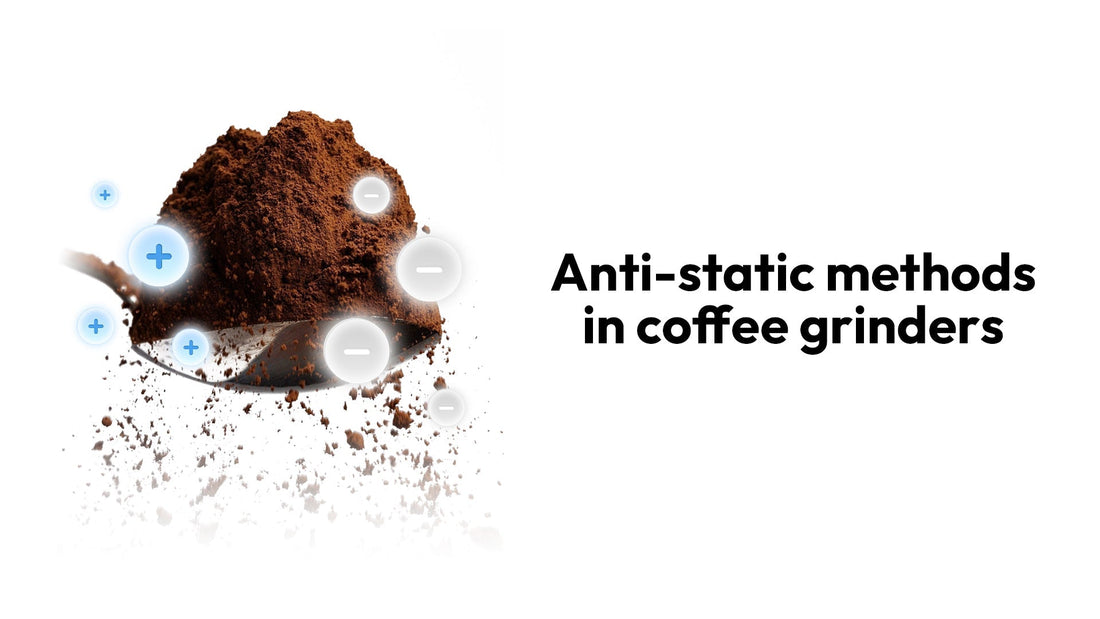Electrostatic Control in Coffee Grinders: Coatings, Electrodes, Grounding & Structural Optimization

Abstract
During the coffee grinding process, high-speed friction between the burrs and coffee beans generates significant static electricity. This is one of the primary causes of coffee grounds scattering, residue buildup, and uneven extraction. Finer particles, with their larger surface area, are especially prone to static charge accumulation, resulting in messy powder dispersion, ingredient waste, and inconsistent cup quality.
Moreover, static electricity causes grounds to cling to the grinder’s internal pathways, leading to contamination from leftover residue, off-flavors, and channeling effects due to uneven density distribution — all of which compromise extraction uniformity and flavor clarity.
To address these issues, several anti-static strategies have been developed, targeting pre-grind, in-process, and post-grind stages. This article introduces five commonly used methods of electrostatic control:
RDT (Ross Droplet Technique)
Grounded discharge plates in the grind path
Ionizer-based static elimination systems
Conductive burr coatings
1、RDT: Ross Droplet Technique
RDT is one of the simplest and most accessible anti-static methods, especially popular among home users and small-scale commercial setups. The technique involves spraying a very fine mist of water on the surface of coffee beans before grinding, increasing their surface conductivity and reducing static buildup during grinding.
The water forms a temporary conductive layer on the beans, significantly minimizing static-induced powder flyaway and reducing retention along the grind chute or spout.

The key to RDT lies in precisely controlling the amount of water sprayed. Typically, 1–2 fine mists for a single grinding dose (around 15–20 grams) are sufficient to suppress static without affecting grinding performance. Excessive water, however, may lead to:
Clumping and uneven particle distribution;
Moisture-oil adhesion on burrs, accelerating clogging;
- Rusting of burrs, especially those without anti-rust coatings.
Environmental humidity plays a role — in areas with >60% humidity, less water is needed to avoid over-wetting.
Overall, RDT offers a low-cost, beginner-friendly solution for static control, though for commercial-scale grinding, it’s best paired with other measures for optimal stability and equipment longevity.
2. Grounding Flaps
In commercial grinders, one common and effective approach to static suppression is the integration of grounded discharge plates at critical points in the grind path. These high-conductivity metal plates create a path to discharge static electricity as coffee grounds pass by, reducing airborne powder and build-up.

As negatively charged coffee grounds move past the discharge plate, electrical charge is transferred through the conductive material and safely grounded, effectively reducing local static potential.
Key design considerations for effective implementation:
Material: Use highly conductive metals like stainless steel (SUS304/316) or copper alloys.
Reliable Grounding: Plates must be securely connected to an effective grounding system, with resistance ideally <5Ω.
Optimized Structure: Plate angle and shape should support smooth powder flow while allowing enough contact time for charge neutralization.
For grinders with plastic parts, additional grounding via copper braids or conductive coatings may be needed to close the grounding loop and ensure dissipation is effective.
3. Ion Generators
In high-end commercial grinders, ionizers offer a highly effective solution for consistent anti-static performance, particularly in clean environments or with challenging beans.

These systems generate a bipolar ion stream (positive and negative ions) via corona discharge or electrode arrays. As charged particles pass through the ion field, they neutralize through charge exchange, significantly reducing powder retention and clumping.
Advantages over traditional methods:
Independent of humidity or bean type;
Real-time neutralization at grind exit point;
Compact design adaptable to various grinder architectures.
4. Specialized Burr Coatings
LeBrew’s Hyperburrs series features a TiAlN conductive coating — a pioneering approach that addresses static at the source by enhancing charge dissipation during initial grinding contact.

The titanium aluminum nitride (TiAlN) coating forms a durable, wear-resistant, and conductive ceramic film on the burr surface, offering:
Low surface resistivity (as low as 10⁴–10⁵ Ω/sq), significantly better than bare stainless steel or ceramic;
Superior hardness and heat resistance, maintaining edge sharpness even under high-speed, high-friction conditions;
Self-passivating behavior, reducing metal ion transfer and preserving flavor integrity.
By channeling charge away from the burr-bean interface and into the grinder’s grounded frame, this structure-based solution reduces static-induced retention and mess, without dependency on external devices or ambient conditions.
Compared to uncoated burrs, LeBrew’s coated burrs offer better grind uniformity, cleaner workflow, and higher performance consistency — ideal for specialty cafés and users seeking ultimate precision.
| Anti-static Method | Advantages | Limitations | Application Scenarios |
|---|---|---|---|
| RDT (Ross Droplet Technique) | Low cost, easy to implement | Sensitive to water volume; may affect burr surface | Home use, small-scale commercial grinders |
| Grounded Discharge Plate | Reliable stability; compensates for plastic components | Requires professional grounding design | Medium to large electric grinders |
| Ionizer System | Unaffected by humidity; stable real-time neutralization | High cost; regular maintenance required | High-end commercial environments |
| Conductive Burr Coating | Enhances charge dissipation at the source | Higher cost; must be paired with effective grounding system | Precision-grade electric grinders |
Conclusion
Static control in coffee grinding is more than just a cleanliness issue — it directly affects powder behavior, flavor clarity, and equipment longevity. At the cutting edge of grinder design, anti-static strategies such as RDT, grounding systems, ionizers, and conductive burr coatings must be integrated thoughtfully.
The design of a coffee burr is a complex system. A good burr requires careful consideration from multiple aspects. LeBrew offers diverse flavor performance possibilities, enabling boundary-breaking grinding from espresso to filter.
Have Questions or Suggestions?
If you have any feedback or would like to know more, feel free to contact us at:
service@lebrewtech.com




